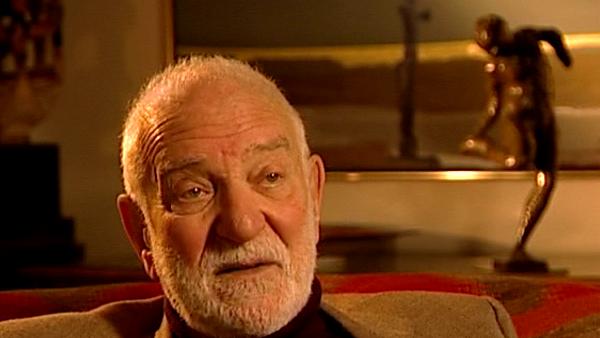NEXT STORY

Inspiration from paintings
RELATED STORIES

NEXT STORY

Inspiration from paintings
RELATED STORIES


|
Views | Duration | |
|---|---|---|---|
| 21. My use of colour | 222 | 07:11 | |
| 22. How to start a sculpture | 315 | 02:56 | |
| 23. Rethinking sculpture | 211 | 07:07 | |
| 24. Teaching and other ways of finding stimulation | 163 | 03:21 | |
| 25. The pros and cons of my career | 167 | 05:03 | |
| 26. Anxiety builds confidence | 156 | 03:28 | |
| 27. Clement Greenberg | 350 | 05:07 | |
| 28. Triangle workshop: A collaboration with Frank Gehry | 231 | 05:24 | |
| 29. Sculpitecture | 280 | 01:50 | |
| 30. The Millennium Bridge: Collaborating with Norman Foster | 280 | 03:30 |


It was collaborative at an early stage. We were all sitting and throwing it around, and it was great. And basically Chris's idea of a sort of guitar string stretched across the Thames was really fundamental to it, and it worked really well. But a lot of the work was done by the Foster... the Foster architecture practice because it had to be worked out... it had to be... we had to... they had to send people down there and count how many boats went through the wrong... the wrong entrance way. And so what height do we have to have? And... and what happens with the... the stones on which the certain sorts of... of worms that are eaten by the fish live? So we had to take them all out. We had to... he had to talk to committees. He did all that; he did all that. Enormous amount of work. It took three years or more and he didn't... he said it was one of the worst experiences going... having to go through thirty committees and talk to them, persuade them every time.
And that side of it was no fun but the building itself, and building and working with Norman, and working with... I find Norman very... very easy to work with; very good to work with; very open. And I found Chris Wise was... was, again, amazing – to have an engineer who could see things so sculpturally. So it was good and I thought... I learnt a lot from it. And I think the bridge is quite beautiful but I don't think I was that much responsible for it because, I mean, a bridge... for example, the landing on the south side was going to be very sculptural and they didn't want sculpture there because they wanted to be able to put big sculptures that were made by... by other artists there. And then Norman and the architect at the Tate weren't friendly with each other so it didn't go in through the Tate and out again. But, you know, there were all sorts of possible things that could have happened which didn't happen because of practical blocks. And we were going to take the idea of it right up to St Paul's where you were going to be able to turn right at St Paul's and go across the river; that's where you'd find you were in the... in the Tate Modern. But it didn't work out that way because there was, you know, a council who said they... they didn't want anything on the steps, you know. It was... it was murder; that was murder. But then I said to Norman, ‘I hate your job; I don't like what goes on, having to cope with all this in an architect's office’. And he said, ‘If you think of architecture as that ring there, that little segment is design and all the rest of it is this sort of thing’. And I realise it's very hard. You see, I've never been in that world. I've never been in the world of commissions. I've been in the world of making my own stuff and hoping for the best, and I'm so pleased I did.
British sculptor Sir Anthony Caro (1924-2013) came to prominence in 1963 after a show at the Whitechapel Gallery. Keen to create a more direct interaction with the viewer he placed pieces directly on the ground, rather than on plinths, a technique now widely used. He held many honorary degrees and was knighted in 1987.
Title: The Millennium Bridge: Collaborating with Norman Foster
Listeners: Tim Marlow
Tim Marlow is a writer, broadcaster and art historian. He founded "Tate: The Art Magazine" in 1993 and was presenter of Radio 4 arts programme "Kaleidoscope" from 1991 to 1998, for which he won a Sony Award. He has presented art programme's on BBC 1, Channel 4 and Channel 5, including a documentary about JMW Turner, and written about art and culture for various British newspapers and magazines including "The Guardian", "The Times" and "Blueprint" He is Director of Exhibitions at the White Cube gallery in London as well as a visiting lecturer at Winchester School of Art, an examiner on the Sculpture MA there and former creative director of Sculpture at Goodwood
Tags: Thames, Tate Modern, Chris Wise, Norman Foster
Duration: 3 minutes, 30 seconds
Date story recorded: November 2005
Date story went live: 24 January 2008